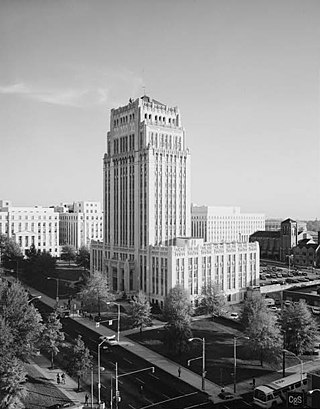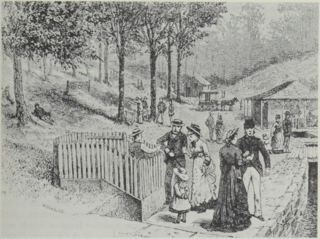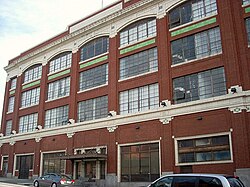
The Ford Piquette Avenue Plant is a former factory located within the Milwaukee Junction area of Detroit, Michigan, in the United States. Built in 1904, it was the second center of automobile production for the Ford Motor Company, after the Ford Mack Avenue Plant. At the Piquette Avenue Plant, the company created and first produced the Ford Model T, the car credited with initiating the mass use of automobiles in the United States. Prior to the Model T, several other car models were assembled at the factory. Early experiments using a moving assembly line to make cars were also conducted there. It was also the first factory where more than 100 cars were assembled in one day. While it was headquartered at the Piquette Avenue Plant, Ford Motor Company became the biggest U.S.-based automaker, and it would remain so until the mid-1920s. The factory was used by the company until 1910, when its car production activity was relocated to the new, larger Highland Park Ford Plant.

The Ford River Rouge complex is a Ford Motor Company automobile factory complex located in Dearborn, Michigan, along the River Rouge, upstream from its confluence with the Detroit River at Zug Island. Construction began in 1917, and when it was completed in 1928, it was the largest integrated factory in the world, surpassing Buick City, built in 1904.

Poncey–Highland is an intown neighborhood on the east side of Atlanta, Georgia, located south of Virginia–Highland. It is so named because it is near the intersection of east/west Ponce de Leon Avenue and north/southwest North Highland Avenue. This Atlanta neighborhood was established between 1905 and 1930, and is bordered by Druid Hills and Candler Park across Moreland Avenue to the east, the Old Fourth Ward across the BeltLine Eastside Trail to the west, Inman Park across the eastern branch of Freedom Parkway to the south, and Virginia Highland to the north across Ponce de Leon Avenue. The Little Five Points area sits on the border of Poncey–Highland, Inman Park, and Candler Park.

Druid Hills Historic District is a historic district in Druid Hills and Atlanta in DeKalb County, Georgia, United States, that is listed on the National Register of Historic Places (NRHP).

Atlanta City Hall is the headquarters of the City of Atlanta government. It was constructed in 1930, and is located in Downtown Atlanta. It is a high-rise office tower very similar to dozens of other city halls built in the United States during the same time period. Located in South Downtown, it is near other governmental structures, such as the Georgia State Capitol and the Fulton County Courthouse. The Neo-Gothic structure features many architectural details that have helped to make the building a historical landmark. It is Atlanta’s fourth city hall.

Atlanta Assembly was an automobile factory owned by Ford Motor Company in Hapeville, Georgia. The Atlanta Assembly plant was opened on December 1, 1947. Harbour Consulting rated it as the most efficient auto plant in North America in 2006. As part of The Way Forward plan, the plant was closed on October 27, 2006. Prior to the operation of this assembly plant, Ford operated another assembly plant and offices on Ponce de Leon Avenue near the old Sears headquarters building, in the Poncey-Highland neighborhood just northeast of Downtown Atlanta.

Ponce de Leon Avenue, often simply called Ponce, provides a link between Atlanta, Decatur, Clarkston, and Stone Mountain, Georgia. It was named for Ponce de Leon Springs, in turn from explorer Juan Ponce de León, but is not pronounced as in Spanish. Several grand and historic buildings are located on the avenue.

North Avenue is a major avenue in Atlanta, Georgia that divides Downtown Atlanta from Midtown Atlanta. North Avenue stretches continuously in Atlanta from Candler Park in the east, across Interstate 75 & Interstate 85, along the southern boundary of the Georgia Institute of Technology, to Joseph E. Lowery Boulevard just southwest of Georgia Tech, where it ends. North Avenue passes through the neighborhoods of Poncey-Highland, Old Fourth Ward, and Midtown Atlanta.

The New Amsterdam Historic District is a historic district located in Detroit, Michigan. Buildings in this district are on or near three sequential east-west streets on the two blocks between Woodward Avenue and Second Avenue. It was listed on the National Register of Historic Places in 2001.

The Piquette Avenue Industrial Historic District is a historic district located along Piquette Street in Detroit, Michigan, from Woodward Avenue on the west to Hastings Street on the east. The district extends approximately one block south of Piquette to Harper, and one block north to the Grand Trunk Western Railroad Line. It was listed on the National Register of Historic Places in 2004.

The Edward C. Peters House, also known as Ivy Hall, is a Queen Anne style house in Atlanta, Georgia. It occupies a lot covering an entire city block on the southeast corner of Piedmont Avenue and Ponce de Leon Avenue in Midtown Atlanta, just north of the SoNo neighborhood. Its current owner is the Savannah College of Art and Design.

The Lincoln Motor Company Plant was an automotive plant at Livernois, 6200 West Warren Avenue Detroit, Michigan, later known as the Detroit Edison Warren Service Center. The complex was designated a National Historic Landmark in 1978, due to its historic association with World War I Liberty engines and the Lincoln Motor Company. However, the main structures were demolished in 2003 and NHL designation was withdrawn in 2005.

Ponce City Market is a mixed-use development located in a former Sears catalogue facility in Atlanta, with national and local retail anchors, restaurants, a food hall, boutiques and offices, and residential units. It is located adjacent to the intersection of the BeltLine with Ponce de Leon Avenue in the Old Fourth Ward near Virginia Highland, Poncey-Highland and Midtown neighborhoods. The 2.1-million-square-foot (200,000 m2) building, one of the largest by volume in the Southeast United States, was used by Sears, Roebuck and Co. from 1926 to 1987 and later by the City of Atlanta as "City Hall East". The building's lot covers 16 acres (65,000 m2). Ponce City Market officially opened on August 25, 2014. It was listed on the National Register of Historic Places in 2016.

Ponce de Leon Springs was a mineral spring in Atlanta, Georgia, in the United States. The spring was a popular tourist destination from the mid-1800s through the early 1900s. Around the turn of the century, the land surrounding the spring was developed into an amusement park. By the 1920s, the amusement park was demolished, and the area was developed for industrial and, later, commercial properties.

Briarcliff Plaza, also known as Ponce de Leon Plaza, is a strip mall-type shopping center designed by architect George Harwell Bond and opened in 1939 at the southwest corner of Ponce de Leon Avenue and Highland Avenue in the Poncey-Highland neighborhood of Atlanta. Braircliff Plaza was developed by Relnac Inc., and was proposed to cost $300,000. Construction began after the last home on the block was purchased by Relnac Inc., the Dr. Robin Adair estate, and Briarcliff Plaza opened throughout 1939 with businesses such as Dupree Dry Cleaners, Blick’s Bowling Alley, Holcomb Flowers, the Georgia Fruit & Vegetable Company and Nick Caruso’s Big Place which offered shoe repair, hat cleaning, pressing, repairing and hat cleaning. It was Atlanta's first shopping center with off-street parking. It is anchored by the historic Plaza Theatre and Urban Outfitters. A portion of the historic plaza area was listed on the National Register of Historic Places in 2020.

The Colonnades are condominium buildings at 734–746 North Highland Avenue in the Virginia-Highland neighborhood of Atlanta, Georgia. They are a contributing property to the Virginia-Highland Historic District, registered on the National Register of Historic Places.
Murder Kroger is the nickname of a Kroger supermarket in Atlanta which has been the scene of two fatal shootings and the discovery of a corpse. It is located at 725 Ponce de Leon Avenue in Poncey–Highland and has been known as "Murder Kroger" for decades. In 1991, a 25-year-old woman named Cynthia Prioleau was shot and killed. In 2002, the malodorous corpse of a man was found inside a car. In 2015, an Alabama man, Joshua R. Richey, was shot and killed. The 2015 murder occurred after the store had been renovated and promoted by the company as "Beltline Kroger".

The Ford Motor Company - Columbus Assembly Plant is a historic building in Downtown Columbus, Ohio. The Ford plant was constructed in 1914, to designs by John Graham. The plant operated until 1939. In later years, it became the Kroger Co. Columbus Bakery, operating until 2019. The building was sold in 2020, and is planned to be redeveloped into a large residential complex, announced in 2021. The building was added to the National Register of Historic Places and Columbus Register of Historic Properties in 2021.
725 Ponce is a 190-million-dollar mixed-use development under construction at 725 Ponce de Leon Avenue along the Atlanta BeltLine in the Poncey-Highland neighborhood of Atlanta, Georgia. It includes a 360,000-square-foot, 12 story office tower atop a new Kroger supermarket replacing the Kroger store demolished in 2016, which will connect to the BeltLine trail via a set of "M.C. Escher-esque steps", restaurants and a covered outside patio.

Ponce de Leon Apartments is a historic apartment building in Atlanta, Georgia, United States. A part of the Fox Theatre Historic District, the building is located at the intersection of Peachtree Street and Ponce de Leon Avenue in midtown Atlanta. It was built by the George A. Fuller Company in 1913, with William Lee Stoddart as the building's architect. The building was designated a Landmark Building by the government of Atlanta in 1993.




























